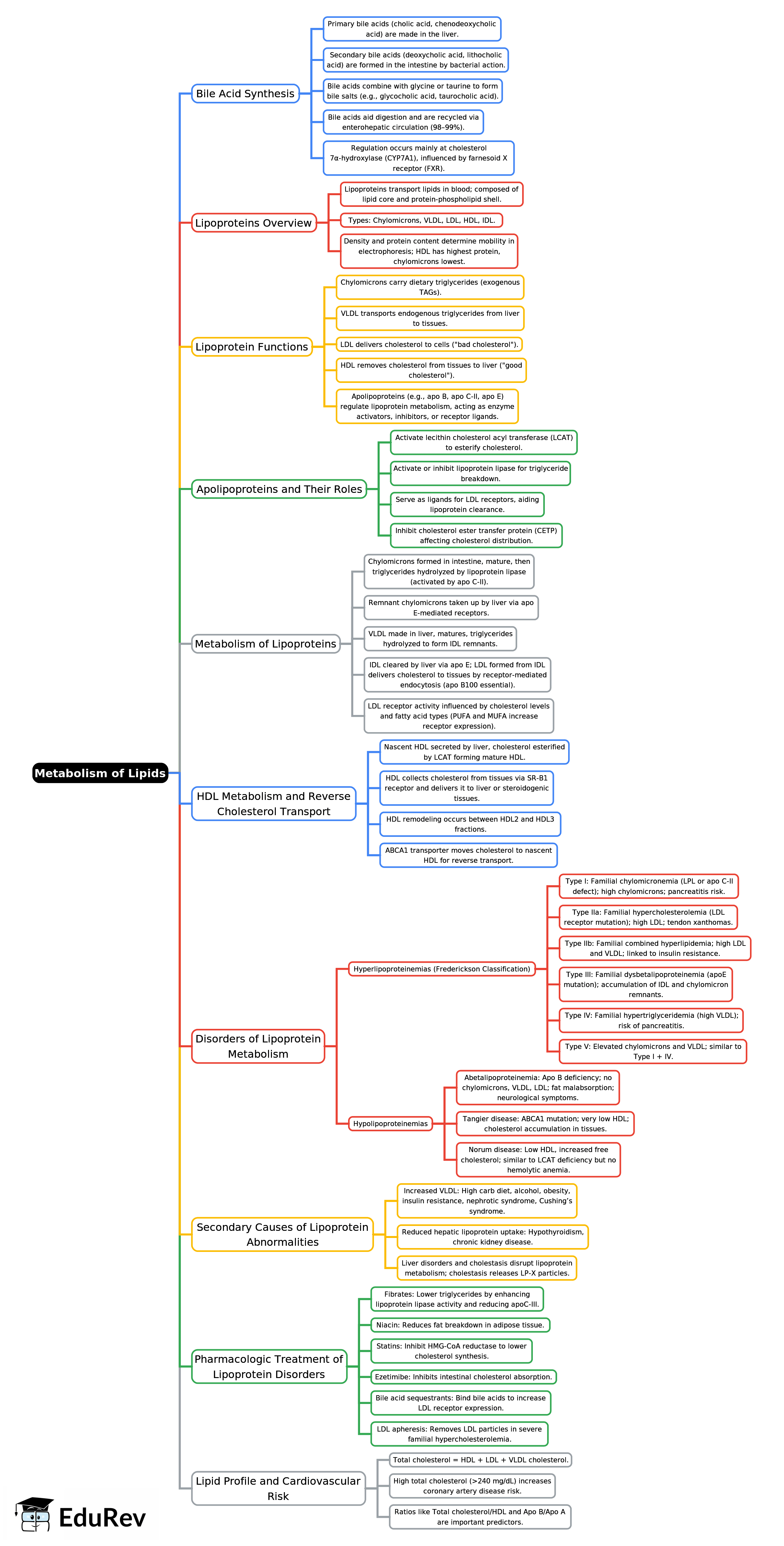ACT Exam > ACT Notes > Chemistry for ACT > Mind Map: Metabolism of Lipids -2
Mind Map: Metabolism of Lipids -2 | Chemistry for ACT PDF Download

The document Mind Map: Metabolism of Lipids -2 | Chemistry for ACT is a part of the ACT Course Chemistry for ACT.
All you need of ACT at this link: ACT
|
110 videos|130 docs|117 tests
|
FAQs on Mind Map: Metabolism of Lipids -2 - Chemistry for ACT
| 1. What are the main pathways involved in lipid metabolism? |  |
Ans. Lipid metabolism primarily involves two main pathways: lipogenesis and lipolysis. Lipogenesis is the process of synthesizing fatty acids and triglycerides from excess carbohydrates and proteins, occurring mainly in the liver and adipose tissue. In contrast, lipolysis is the breakdown of triglycerides into free fatty acids and glycerol, which can then be utilized for energy production, primarily in muscle and liver tissues. Other key processes include beta-oxidation, which occurs in the mitochondria and involves the degradation of fatty acids to produce acetyl-CoA for the Krebs cycle, and ketogenesis, which converts excess acetyl-CoA into ketone bodies during periods of low carbohydrate availability.
| 2. How are fatty acids transported in the body? |  |
Ans. Fatty acids are transported in the body primarily in the form of triglycerides within lipoproteins. After digestion, dietary fats are emulsified by bile salts and further broken down by pancreatic lipases into free fatty acids and monoglycerides, which are absorbed by intestinal cells. Inside these cells, fatty acids are re-esterified into triglycerides and packaged into chylomicrons, a type of lipoprotein. Chylomicrons enter the lymphatic system and eventually reach the bloodstream, where they deliver fatty acids to tissues. Additionally, free fatty acids can be transported in the blood bound to serum albumin, especially during fasting or prolonged exercise.
| 3. What role do enzymes play in lipid metabolism? |  |
Ans. Enzymes play crucial roles in lipid metabolism by facilitating the various biochemical reactions involved in both lipogenesis and lipolysis. Key enzymes include acetyl-CoA carboxylase, which catalyzes the conversion of acetyl-CoA to malonyl-CoA, initiating fatty acid synthesis. Hormone-sensitive lipase (HSL) is vital for lipolysis, breaking down stored triglycerides into free fatty acids and glycerol. Other important enzymes include fatty acid synthase, which elongates fatty acid chains, and carnitine acyltransferase, which transports fatty acids into the mitochondria for beta-oxidation. The regulation of these enzymes is influenced by hormonal signals, nutritional status, and energy needs.
| 4. What is the significance of ketone bodies in lipid metabolism? |  |
Ans. Ketone bodies, primarily acetoacetate, beta-hydroxybutyrate, and acetone, are significant byproducts of fatty acid metabolism, particularly during periods of low carbohydrate availability, such as fasting, prolonged exercise, or carbohydrate-restricted diets. They are produced in the liver through the process of ketogenesis, where excess acetyl-CoA derived from fatty acid oxidation is converted into ketone bodies. Ketone bodies serve as an alternative energy source for tissues, particularly the brain and muscles, when glucose levels are low. Their production helps to spare glucose and preserve muscle protein, making them a critical component of energy metabolism during starvation or low-carb states.
| 5. How does insulin affect lipid metabolism? |  |
Ans. Insulin plays a pivotal role in lipid metabolism by promoting lipogenesis and inhibiting lipolysis. When insulin is released from the pancreas in response to elevated blood glucose levels, it stimulates the uptake of glucose and fatty acids into adipose tissue and the liver. Insulin activates acetyl-CoA carboxylase and fatty acid synthase, promoting the synthesis of fatty acids and triglycerides. Additionally, insulin suppresses the activity of hormone-sensitive lipase, reducing the breakdown of stored triglycerides into free fatty acids. Thus, insulin effectively facilitates fat storage and energy conservation when energy substrates are abundant.
Related Searches















